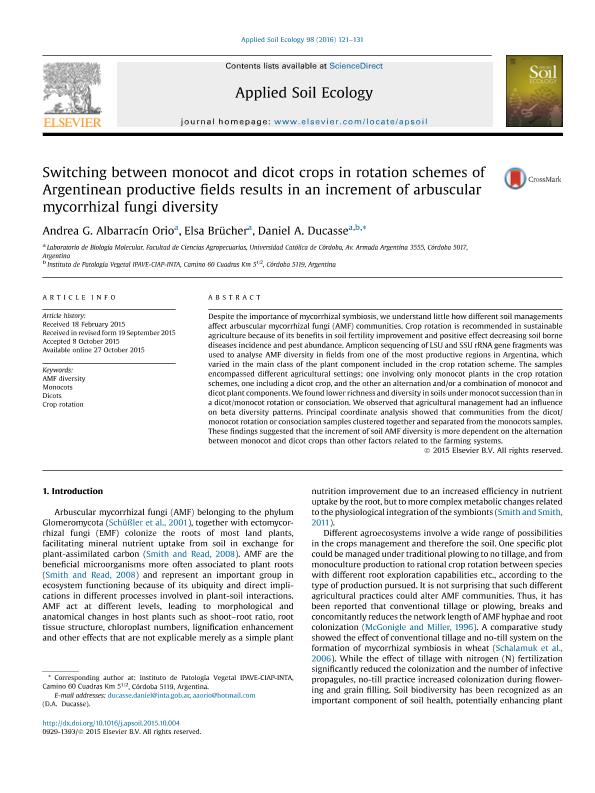Artículo
Switching between monocot and dicot crops in rotation schemes of Argentinean productive fields results in an increment of arbuscular mycorrhizal fungi diversity
Fecha de publicación:
02/2016
Editorial:
Elsevier Science
Revista:
Applied Soil Ecology
ISSN:
0929-1393
Idioma:
Inglés
Tipo de recurso:
Artículo publicado
Clasificación temática:
Resumen
Despite the importance of mycorrhizal symbiosis, we understand little how different soil managements affect arbuscular mycorrhizal fungi (AMF) communities. Crop rotation is recommended in sustainable agriculture because of its benefits in soil fertility improvement and positive effect decreasing soil borne diseases incidence and pest abundance. Amplicon sequencing of LSU and SSU rRNA gene fragments was used to analyse AMF diversity in fields from one of the most productive regions in Argentina, which varied in the main class of the plant component included in the crop rotation scheme. The samples encompassed different agricultural settings; one involving only monocot plants in the crop rotation schemes, one including a dicot crop, and the other an alternation and/or a combination of monocot and dicot plant components. We found lower richness and diversity in soils under monocot succession than in a dicot/monocot rotation or consociation. We observed that agricultural management had an influence on beta diversity patterns. Principal coordinate analysis showed that communities from the dicot/monocot rotation or consociation samples clustered together and separated from the monocots samples. These findings suggested that the increment of soil AMF diversity is more dependent on the alternation between monocot and dicot crops than other factors related to the farming systems.
Palabras clave:
AMF DIVERSITY
,
CROP ROTATION
,
DICOTS
,
MONOCOTS
Archivos asociados
Licencia
Identificadores
Colecciones
Articulos(CCT - CORDOBA)
Articulos de CTRO.CIENTIFICO TECNOL.CONICET - CORDOBA
Articulos de CTRO.CIENTIFICO TECNOL.CONICET - CORDOBA
Citación
Albarracín Orio, Andrea Georgina; Brücher, Elsa; Ducasse, Daniel Adrián; Switching between monocot and dicot crops in rotation schemes of Argentinean productive fields results in an increment of arbuscular mycorrhizal fungi diversity; Elsevier Science; Applied Soil Ecology; 98; 2-2016; 121-131
Compartir
Altmétricas




